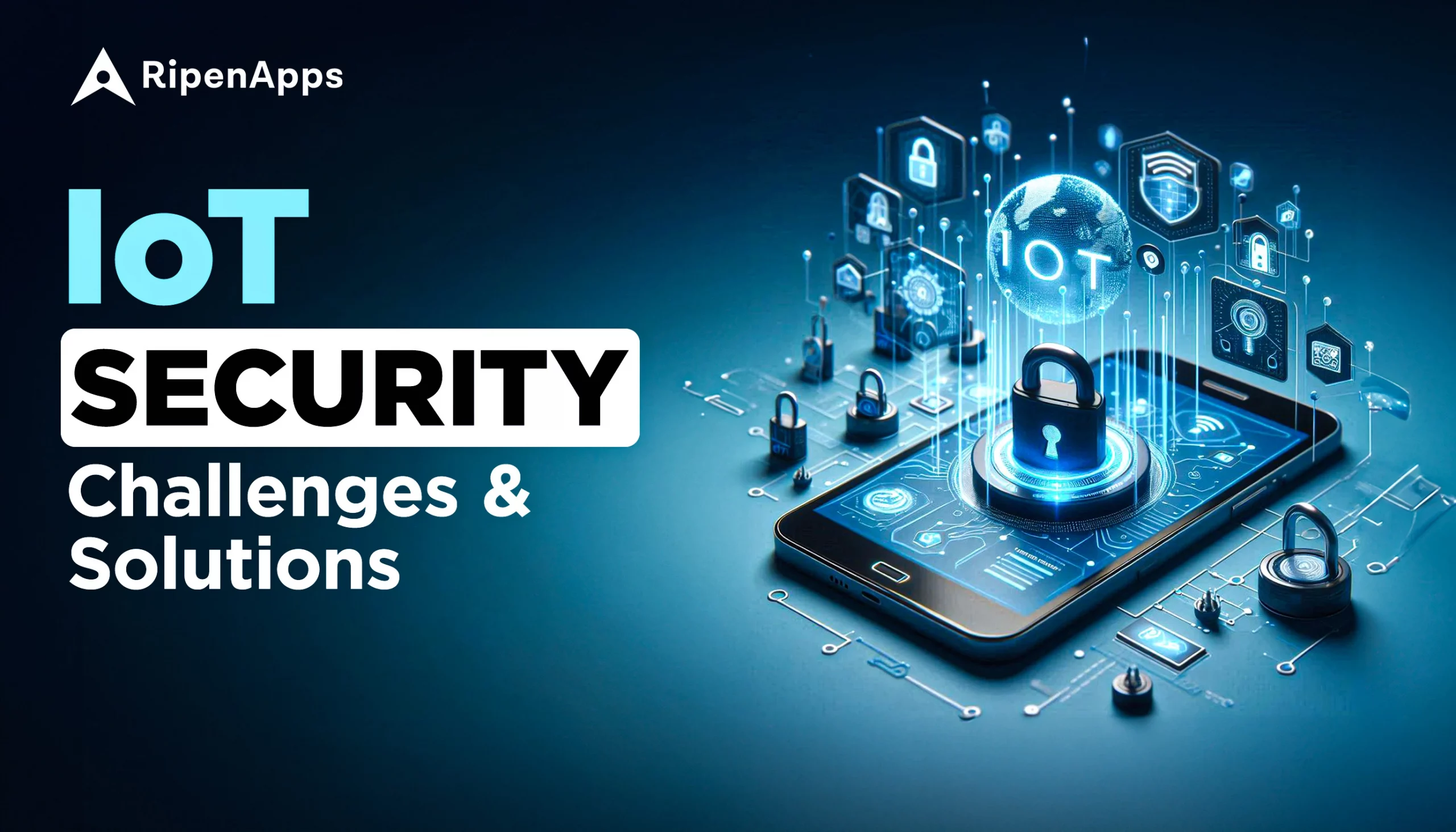Did you know that cyber-attacks on IoT devices have increased to a great extent? This is an alarming sign to pay attention to the critical importance of securing your IoT infrastructure.
According to Statista, the number of IoT devices worldwide is over 15.9 billion in 2O23. It is expected to reach more than 32.1 billion IoT devices by 2030. From this, we can expect that the demand for IoT integration is going to rise at a rapid speed.
However, with the rising need for IoT, here comes a critical question: How secure are these Internet-connected devices?
The Internet of Things includes a network of interconnected machines that collect and have a lot of data. Although IoT-connected devices are convenient and efficient, there are multiple security concerns that you must address. It is crucial to tackle IoT security challenges to protect the integrity of the data collected by these IoT devices.
So, whether you are a business owner, tech enthusiast, or IoT app developer, you must understand and mitigate these challenges. Here, we have explained various IoT security challenges and all the possible solutions.
Table of Contents
Key IoT Security Challenges Faced By Businesses
1. Weak Authentication
One of the major challenges of securing IoT devices is non-existent authentication. Most IoT devices establish their identity before they access gateways. Still, there are several connected devices which have minimum security. For Instance, the integration of IoT in logistics presents unique security challenges. IoT devices are used to track and manage inventory or to optimize supply chain operations. Therefore, these devices become targets for cyber-attacks to steal sensitive data.
Due to weak authentication, attackers can have unauthorized access to IoT devices. This can result in data breaches, loss of sensitive data and unauthorized control. Not only this, the attackers can easily manipulate or corrupt the data. As a result, it can have a great impact on business owners who rely on data to make major decisions.
2. Data Security Concern
Integration of IoT in mobile app development across industries comes with a notable challenge i.e. safety concerns. Security of your devices is mandatory to prevent data breaches.
Major security issues involve the following:
- Cyber attack on IoT devices
- Data theft
- Network security
- Unpatched vulnerability
- API and app security
- Device authentication or lack of effective access control
- Lack of security frameworks and controls
- User password
- Physical security
In the past few years, several respondents come across IoT device attacks. However, it is due to a lack of skilled personnel to safeguard sensitive data.
If you want to create a robust IoT ecosystem, you need to address these challenges in IoT security. Finding solutions to safeguard your data can provide a safe and secure environment.
3. Limited Scalability
In the ever-evolving digital scenario, managing multiple IoT devices can cause scalability issues. You need to integrate your devices with existing networks and systems to maintain security and reliability.
As the number of internet-connected devices continues to increase, managing IoT infrastructure can become difficult. You may encounter the issue on various fonts. For example: smart home apps are often connected to multiple IoT devices, which increases the
attack surface for cyber threats. It can easily lead to unauthorized access to home security systems.
4. Long-Term Device Interoperability Issues
IoT devices are utilized in different communication protocols such as Z-Wave, Zigbee, Wi-Fi etc. Interoperability issues due to systems, platforms and devices from various manufacturers. Moreover, with varying standards, they are not able to communicate effectively. Thus, comes with significant hurdles to create a cohesive IoT ecosystem.
Interoperability issues are a significant challenge because of integration complexity. If you are not able to handle them, it can lead to increased development costs and time.
5. Regulatory Compliance in IoT
One of the most crucial IoT security issues is regulatory compliance. It refers to the necessity for all IoT solutions to strictly adhere to industry standards, laws and regulations. Adhering to regulations to expand your IoT operations can cause several hurdles. This IoT security challenge is multi-faceted due to the following valid reasons:
- Diverse Set of Regulations: Different regions have their own sets of rules and regulations concerning data privacy and device safety. We can see GDPR in Europe, CCPA in California and many more.
- Complex Compliance: IoT devices raise a major concern about data privacy and protection. You need to implement security measures, maintain detailed records and conduct regular audits. All these can become complex and costly to a great extent.
- Evolving Regulatory Landscape: With emerging technologies, even laws and regulations are updated to face new IoT security challenges. Constant adaptation can help you to keep up with these changes. For business owners, it can become resource-intensive and expensive.
If you fail to comply with regulatory compliances, you might face legal problems, financial losses or even loss of the company’s reputation. That’s why, it’s crucial to ensure regulatory compliance in IoT.
Effective Solutions for IoT Security Challenges
1. Implement Strong Authentication Mechanisms
As discussed above, weak authentication is the most critical IoT security challenge. To cope with this, you can use multi-factor authentication (MFA) and even robust password policies. By doing this, only authorized users and devices can access your IoT networks and have sensitive data. You can implement biometric authentication to add an extra layer of security.
Organizations must implement robust encryption protocols and regular security audits to safeguard their IoT networks. You can reduce the risk of IoT-related breaches by creating awareness about the importance of security practices.
To implement strong authentication measures, you can get help from top app development companies dealing with IoT integration, their team will ensure that they are incorporating robust authentication mechanisms into your IoT application.
Read Also: IoT App Development: Useful Tips for Building Top-Notch IoT Apps
2. Regular Firmware and Software Updates
To maintain the security, performance, and functionality of IoT devices, you need to keep a close eye on the regular firmware and software updates.
Regular updates are important due to the following reasons:
- Updates can provide patches to fix vulnerabilities and prevent potential exploitation by attackers. Without timely updates, your IoT devices may be exposed to several threats and hackers can easily target your system.
- Firmware and software updates can fix bugs easily. It ensures that your device will operate smoothly.
- To optimize the performance of IoT devices, you need to enhance your firmware. It will improve battery life, and processing speed and will provide a better user experience.
By availing of professional Internet of Things development services, you can ensure that your IoT devices receive regular firmware and software updates.
3. Implement Device and Network Monitoring
Continuously monitoring your device and network is crucial to maintaining IoT ecosystems’ security and integrity. You can monitor unusual or suspicious activities. Business owners can quickly identify and respond to potential threats by monitoring network traffic.
There are several tools such as Intrusion Detection Systems(IDS) and security information and event management (SIEM) solutions to gather, analyze data and prevent unauthorized access. By utilizing these resources effectively, you can identify and respond to threats in real-time.
4. Adopt Secure Development Practices
Another effective solution to cope with the IoT security and privacy challenges is to follow secure coding practices. Secure IoT app development practices include following coding standards, regular code reviews and vulnerability testing.
Developers or IoT app development companies can perform regular security testing during the IoT application development. Industry experts suggest conducting threat modelling and vulnerability assessments to ensure safety.
So You can adopt various methodologies and security practices to identify and mitigate iot security risks and challenges in the development process. It ensures compliance with industry standards. As a result, it will help you reduce the costly security breaches post-deployment.
5. Regular Security Audits and Compliance Checks
The need for regular security audits and compliance checks is crucial. You need to pay attention to comprehensive assessments of security procedures and policies. For this, you can get assistance from top app development companies for regular security audits to strengthen your device’s privacy and security.
This approach will help you meet all the legal and industry-specific regulations to avoid penalties and build trust. Conducting these evaluations demonstrates their commitment to protecting the data and maintaining IoT system integrity.
Final Thought
In conclusion, navigating IoT security is essential to protect the data reliability of interconnected devices.
Weak authentication, data encryption issues, device interoperability, and regulatory compliance hurdles are common challenges in IoT security. They can allow attackers to manipulate your critical information.
Therefore, to address all these challenges, you require a multifaceted approach, implement robust authentication mechanisms, and adopt secure IoT app development practices.
By implementing these solutions, business owners and IoT app developers can significantly enhance their IoT security framework. This approach not only safeguards their system but also promotes continuous growth and innovation within their IoT ecosystem.
Frequently Asked Questions
Q1. What are the biggest IoT security risks and challenges?
Some of the biggest IoT security risks and challenges include weak authentication mechanisms, lack of encryption, and vulnerabilities in device firmware etc.
Q2. What are the challenges of securing IoT devices?
Securing IoT devices is a challenging task because of limited processing power, and multiple and complex IoT ecosystems. Apart from that, lack of standardized security protocols for various internet-connected devices.
Q3. What are the biggest IoT security risks?
The biggest IoT security risks can be unauthorized access and control of your devices and systems. Other than that, data breaches privacy violations and denial-of-service attacks can disrupt device functionality.











 India
India USA
USA Australia
Australia Canada
Canada UK
UK UAE
UAE